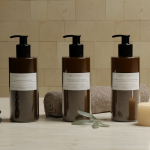
Your guide to The Different Types of Home Fragrances: Candles, Diffusers & More
11 October 2024
How to use Liquid Black Soap in your daily beauty routine
31 October 2024Caring for combination skin can be a challenge. This type of skin generally has dry areas on the cheeks and oilier areas on the T-zone (forehead, nose, chin). Finding the right products requires a balanced approach: you need to moisturize the dry areas without weighing down the oily zones, while regulating excess sebum. In this article, we explore which ingredients to choose and which to avoid for a skincare routine suited to combination skin.
Ingredients to look for for combination skin
1. Hyaluronic acid
Hyaluronic acid is a key moisturizing ingredient. It draws moisture into the skin’s deeper layers without clogging pores. As a light moisturizer, it is particularly suited to combination skin, nourishing dry areas without aggravating oilier ones. Used daily, it helps preserve the skin’s elasticity and suppleness.
2. Niacinamide
This multifunctional active ingredient is ideal for combination skin. Niacinamide (or vitamin B3) helps regulate sebum production, reducing shine in the T-zone while improving hydration in dry areas. It also strengthens the skin barrier and reduces redness, for a more even complexion.
3. Alpha-hydroxy acids (AHA)
AHAs, such as glycolic acid or lactic acid, are gentle chemical exfoliants that promote cell renewal. They unclog pores in oily areas, while removing dead cells in dry areas. Used in small quantities, they help prevent sebum overproduction while improving skin texture.
4. Green clay
Green clay is excellent for oily areas. It absorbs excess sebum and helps deeply purify the skin. Used as a mask once or twice a week, it balances the skin without causing excessive dryness.
Ingredients to avoid for combination skin
1. Comedogenic oils
Some oils, like coconut oil, are too heavy for combination skin. They can clog pores and lead to imperfections, especially in oily areas. Choose light oils like jojoba oil, which is close to the skin’s natural sebum.
2. Denatured alcohol
Although some alcohol-containing products promise a mattifying effect, they can actually dry out the skin, causing the sebaceous glands to produce even more sebum. This can further unbalance combination skin, causing irritation in dry areas.
3. Sulfates
Sulfates, often found in cleansers, can be too aggressive for combination skin. They remove not only excess sebum, but also the skin’s natural moisture. This can exacerbate dry patches and stimulate sebum production in oily areas.
4. Strong essential oils
Although some essential oils have antibacterial or anti-inflammatory properties, combination skin types should avoid overly concentrated essential oils, such as peppermint oil or clove oil, which can irritate sensitive areas of the skin.
How can you adapt your skincare routine?
An effective routine for combination skin must be balanced and adapted to each facial zone. Here are a few practical tips:
- Cleansing: Opt for a gentle, sulfate-free cleanser, such as a water-based gel cleanser. This purifies the T-zone without stripping cheeks of their moisture.
- Hydration: Use a light moisturizing cream with hyaluronic acid to nourish without weighing down the skin.
- Masks: Apply clay masks only to oily areas, and opt for moisturizing masks for dry areas.
- Exfoliation: Use AHAs to gently exfoliate the skin while promoting cell renewal, without aggression.
Integration of natural ingredients
If you’re a fan of natural products, you should know that some natural ingredients are particularly beneficial for combination skin. For example, aloe vera gel is an excellent light moisturizer for combination skin. It deeply moisturizes while soothing redness. To explore these options further, check out our guide to the best natural ingredients for oily skin, which offers natural alternatives for regulating sebum production without aggressing dry areas.
Nature-inspired ingredients for combination skin
Ingredients of natural origin are becoming increasingly popular in beauty routines, notably for their tolerance and beneficial effects. Here are a few that are particularly suitable for combination skin:
1. Jojoba oil
Jojoba oil is one of the few plant oils suitable for combination skin. It is very close to the skin’s natural sebum, making it an excellent choice for regulating sebum production without clogging pores. To find out more about the benefits of natural oils for the skin, take a look at this detailed Healthline article.
2. Green tea extract
Green tea is a powerful antioxidant that helps reduce inflammation and balance sebum production, which is perfect for combination skin prone to blemishes. To delve deeper into its properties and skin benefits, you can read this excellent article from Medical News Today.
Conclusion
Caring for combination skin requires a balanced approach that combines hydration and sebum control. By choosing the right ingredients, such as hyaluronic acid and niacinamide, while avoiding comedogenic oils and irritating products, you can maintain healthy, radiant skin. Tailor your routine to the specific needs of each area of your face, and opt for gentle ingredients for optimum results.
Frequently asked questions (FAQ)
1. Can I use oils for combination skin?
Yes, but choose non-comedogenic oils like jojoba oil. They moisturize without clogging pores.
2. How often should I use clay masks?
Once or twice a week on oily areas (T-zone) is enough to control excess sebum.
3. Is hyaluronic acid suitable for oily and dry skin?
Absolutely, hyaluronic acid is moisturizing without being greasy, making it perfect for combination skin.








